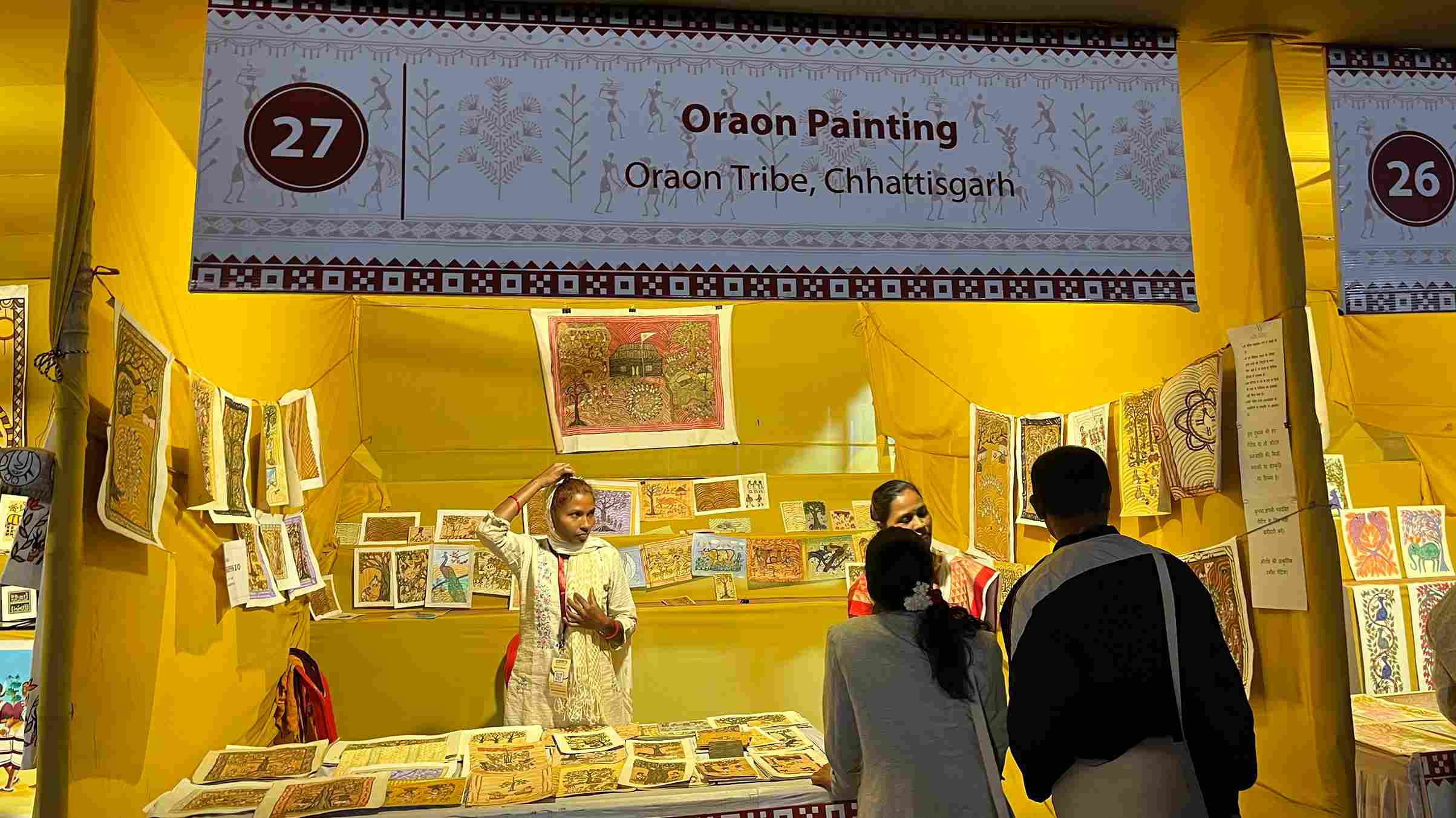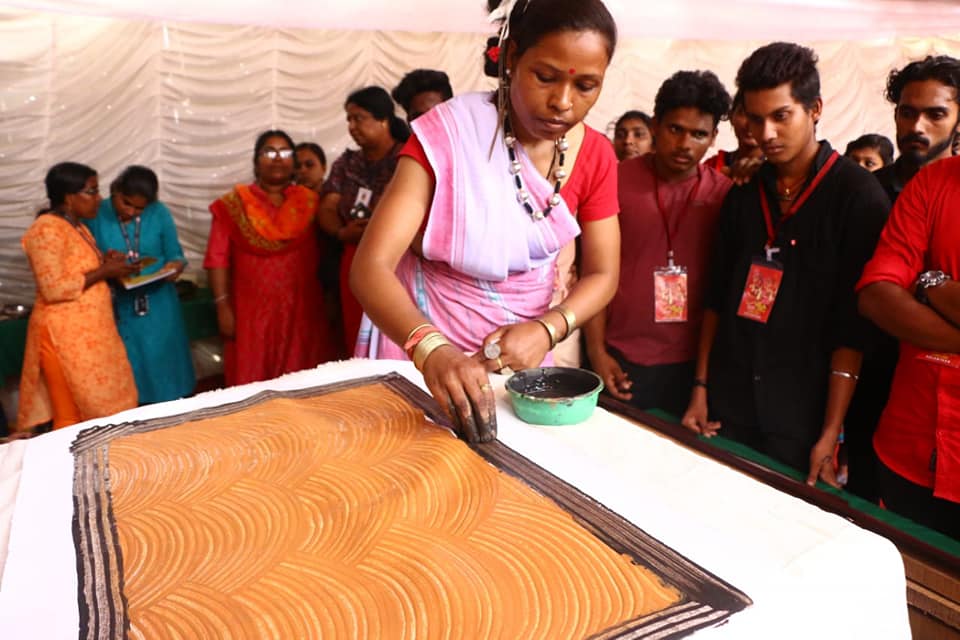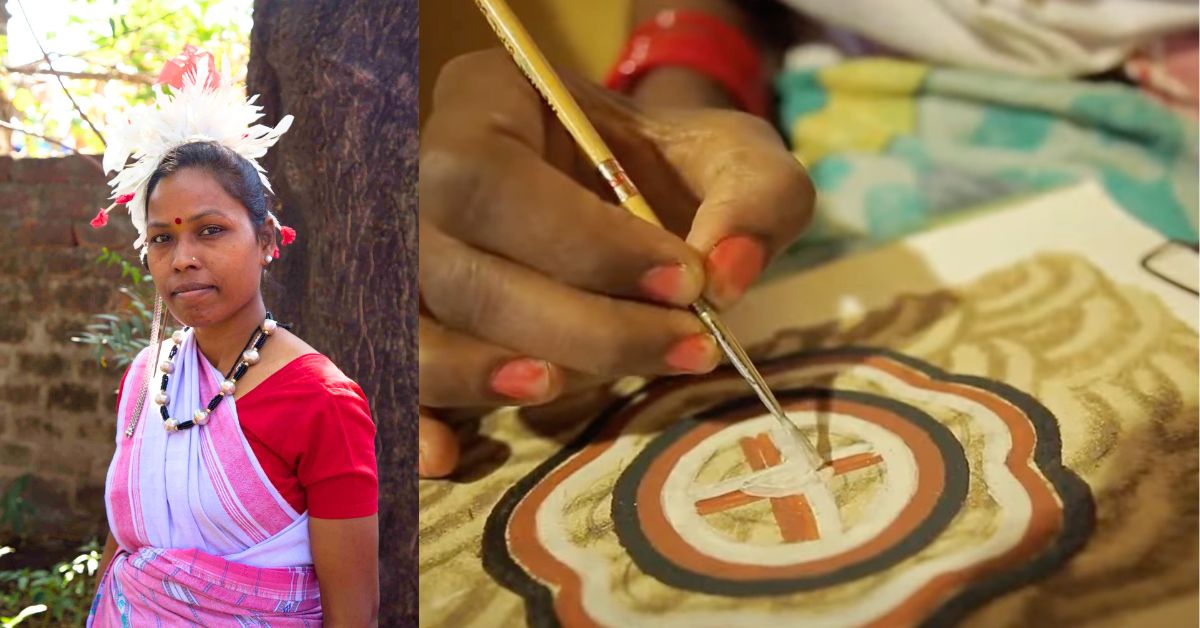
[ad_1]
This text has been printed in partnership with Samvaad – Enabled by Tata Metal Basis
On 15 November, 2023, Sumanti Devi, wearing a pink and white cotton saree, maintained a composed manner regardless of her pleasure. With a job to fulfil and a task to embody, she hid her emotions and ready for the upcoming buzz at Jamshedpur’s Gopal Maidan.
“That is my tenth 12 months of placing up a stall at Samvaad, and but the jitters are very a lot there,” she advised The Higher India as she neatly positioned Oraon work in her stall. She had carried greater than 100 conventional work made by her and her household.
Sumanti works laborious to protect her group’s id and tradition by means of her involvement in Samvaad, an annual conclave organised by the Tata Metal Basis (TSF).
For 5 days, Sumanti and 109 different artisans showcased their cultural heritage by means of various creations like hand-printed silks, textiles, woven materials, mud work, bamboo objects, and conventional clothes stalls from 15 to 19 November, 2023. The theme for Samvaad 2023, ‘Stroll with Me’, centered on the journey of concepts, collectives, and changemakers related to Samvaad since its starting.
Sadly, most of the creative traditions in India are shedding their relevance. Whereas some communities are embracing trendy strategies like artificial colors and brushes, others, like Sumanti, are steadfastly preserving their authentic methods to safeguard these artwork types.
“The following era doesn’t wish to proceed their creative traditions as they’re shifting to different sources of livelihood resulting from lack of correct remuneration. We’re engaged on the revival of tribal artwork and craft,” Smita Verma, Lead – Gender & Group Enterprise at TSF, tells The Higher India.

‘Mud and fingers are our USP’
There aren’t any data of when Oraon work originated. Sumanti says the work are a number of centuries outdated and have been handed down from one era to a different. She grew up seeing her household, kin, and neighbours do Oraon portray on the partitions on varied events within the Jashpur district of Chhattisgarh.
“Calendars didn’t exist for me. I might inform which month or competition was developing primarily based on the portray my mom did on our home partitions. For example, folks would draw the karam tree (Nauclea Parvifolia) forward of the harvest competition. Drawing an egg in between rice grains meant Danda Kattna pooja for auspicious actions,” she shares.
The peculiar factor about Oraon work is that mud types the principle base as a result of availability of varied sorts of soils. The group creates completely different shades of black, brown and pink from the soil. Inexperienced and white colors are made out of leaves and rice respectively.
Sumanti says she provides glue to the colors in order that it sticks to the canvas. Up to now, she and the folks from her village haven’t used acrylic or artificial colors.
She mentions two causes for this, “Firstly, accessibility and value got here in the way in which, and secondly, pure colors are an important a part of our id. Our ancestors have been confined to villages, so that they made pure colors on their very own and took satisfaction in them.”
Colors that come from the soil are seen as sacred, she informs. The elders of the home carry out a short ritual, praying for an obstacle-free seek for the proper soil. Whereas pink and brown soils have been readily accessible, discovering black ones was difficult at the moment.
“Our ancestors must dig in forests to seek out the black soil. The rarity issue makes the soil so necessary in our tradition. In addition to, these three colors are utilized in all our pujas so far. In accordance with a legend, Mahadev and Parvati ji advised our ancestors to make use of these colors,” she shares.
Like colors, the first themes additionally stay intact within the Oraon work. Principally, the work depict group life — together with their dance, customs, forest deities and festivals. The making can take as much as 10 to fifteen days as a result of layered course of. Every layer has to dry earlier than the second layer is accomplished.
For all of the work, Sumanti makes use of her fingers and material (for dabbing) although using a brush is slowly penetrating the group, “However mud and fingers are our USP,” she says.
All these elements are what makes artwork a lot extra priceless and private. The work don’t preach or inform how one ought to stay. As a substitute, it depicts Oraon’s tradition most actually.
“Artwork is a lifelong instructor. It has taught me to be truthful in direction of myself and make one of the best of my circumstances. It’s a reminder that regardless of the harshness of life, monetary burdens, incomplete desires and annoyed days, it’s okay. Each time I paint, it reveals me the real benefit of life,” she shares.

Saving the fading artwork
Sumanti seen migration and a decline in her village’s artwork over time. Her effort to take Oraon work to the recognition of Madhubani or Gond began 15 years in the past. She pioneered the transition of those work from partitions to material and handmade paper. At present, her artworks have journeyed throughout India, from Jammu and Kashmir, Maharashtra, and Chhattisgarh to Kerala.
“It began with a tribal artwork truthful workshop in Bhubaneswar organised by Indira Gandhi Rashtriya Manav Sangrahalaya. We solely bought one portray, nevertheless it gave us hope that if finished accurately, it might be a viable choice. Just a few years into doing exhibitions and native haats, I learnt about Samvaad. I joined the initiative as a fellow. As a part of the fellowship, I launched an artwork curation e-book titled ‘Evam Kala’ on Oraon folklore, documenting the tradition and traditions,” says Sumanti, who has a grasp’s diploma in political science.
She shares that she additionally attends handicraft and artwork workshops by Samvaad to study new market tendencies and expertise that may assist her with extra gross sales.
“While you arrange a stall in an exhibition, there’s a lot extra than simply promoting the work. I learnt that in the event you put on conventional clothes in exhibitions, extra folks have a tendency to go to your stall. The way in which you place your work in a small space additionally issues lots. For instance, all the time have a delicate and muted portray between two vibrant work. It serves as a palette cleanser. Even the way in which you speak to folks and inform your story issues. I learnt all this and extra from specialists who conduct Samvaad workshops,” Sumanti says.

In addition to being an energetic participant in exhibitions, she can also be passing on her expertise to youngsters.
“Together with telling the households in our village why Oraon work are necessary, I additionally inform them the monetary perks and recognitions that include it. I share with them the explanation why we’ve got been making earnings. I inform them that individuals, who’ve by no means heard about our tribe, like what we make! And it may be a profitable profession choice. A number of households are actually both passing on the talents to their children themselves or sending them to me for courses,” she provides.
Samvaad is a big gathering that features over 200 tribal communities and brings collectively greater than 2,500 folks to have fun tribal id, artwork, therapeutic practices, and tradition.
(Edited by Pranita Bhat; All pictures courtesy: Samvaad by Tata Metal Basis)
[ad_2]